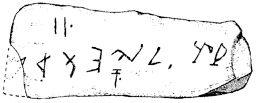 |
Science Frontiers ONLINE No. 84: Nov-Dec 1992 |
|
|
THE "AMERICA BEFORE COLUMBUS" CONFERENCE
 Tennessee Bat Creek stone with supposed Hebrew characters |
- 5000-year-old pottery found in coastal Peru bears an uncanny resemblance to pottery made in
Japan during the same period. How could the Japanese have reached Peru circa 3000 BC? Easy!
Storms could have blown fishermen into the trans-Pacific current. (See "Current
Treads" item under GEOPHYSICS.)
- The Zuni Indians of New Mexico may have been influenced by Japanese voyagers in the
Thirteenth Century, as suggested by their distinctive blood chemistry, language, and culture.
- 700-year-old temple art from India reveals detailed depictions of ears of corn, which was
supposedly unknown outside the Americas until after Columbus.
- Jewish refugees from the Roman Empire may have somehow reached eastern Tennessee, if the famous Bat Creek Stone really bears an ancient Hebrew inscription. The grave in which the stone was found has been carbon-dated between 32 and 769 AD.
(Wilford, John Noble; "Case for Other Pre-Columbian Voyagers," New York Times, July 7, 1992.)